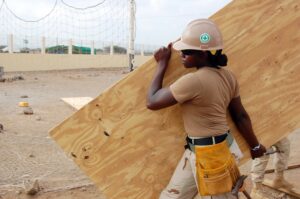by Elise Ferguson, Hannah Lyons-Cavazos, and Tara McElhinney
The Green Jobs Landscape
Through its adoption of the Climate Leadership and Community Protection Act (CLCPA) in 2019, the state of New York has crystallized its commitment to renewable energy and climate justice into law. As a state with enormous energy requirements, particularly in its urban centers, New York will need to undertake substantial infrastructural investments to reduce its reliance on fossil fuels and redirect resources to the renewable energy sector. The creation and maintenance of this new infrastructure will require redirecting substantial numbers of skilled workers across multiple sectors and is likely to create new classes of ‘green’ jobs as well. What does the future of ‘green’ employment look like in the state of New York?

Bridging the Gap with Justice in Mind
With any luck, says Workforce Development Institute analyst Eliot Cresswell, the CLCPA will usher in an inclusive new chapter of workforce transformation. He states that the Act creates a context for energy jobs and emphasizes the need to bridge the gap between our current and future workforce to help achieve the State’s goals. He stresses that we should not just focus simply on employment, but also on good wages, benefits, voice, respect, collective bargaining where appropriate, health and safety, among other considerations for these emerging jobs. Not only do we need a transition, we need a just transition if we are going to make climate action inclusive, viable and attractive for all.
Who are the ‘green workers’ of tomorrow?
Where are we going to get all these workers? Cresswell believes it is mostly a matter of mobilizing and upskilling folks already among us. There is a need to equip current trade workers–operating engineers, electricians, sheet metal workers, etc.–with certain additional skills needed for renewables work. He also believes that public education should play a role in preparing young people to enter this job market. Teachers and guidance counselors should be given resources to help them tap into the growing green job market and present this to students as a future career option.
The Importance of Education
Jessica Clegg, Community Engagement Coordinator at Citizens for Local Power, shares this sentiment. She is hoping to see trade schools, which haven’t always been the traditional route for students, become a more trodden path for students. She also sees a need for training programs, especially for historically underrepresented groups in the field including minorities, women, and low-income individuals. She would like to see more mentorship to pass deep-seated industry knowledge to the future workforce, starting as early as high school (or even earlier!).
What counts as a ‘green job’ anyway?
Not all ‘green jobs’ will be energy-related, however. There will be plenty of opportunities across many sectors. Cresswell notes that ‘green’ is difficult to define and everyone might view it a little differently. Green jobs could include building seawalls, fortifying parks, maintaining fish habitat, and more. Clegg sees great potential for green jobs in the building sector, like working on building restorations which could include sealing attics and basements, improving ventilation and insulation, and mold remediation. She also points to a myriad of other professions like water testers, stormwater planters and green infrastructure implementation. Clegg and Cresswell themselves are also testaments to the fact that not all green jobs are hands-on and construction- or trade-related. There are whole other categories such as administrative work, not to mention lawyers, permitting professionals, etc.
How durable are green jobs?
Admittedly though, many green jobs are directly related to the retrofitting of the energy sector. The question arises, how long-lasting are such jobs? Will people be trained for green jobs just to be left in the dust after the economy has transitioned to renewable energy? Cresswell thinks not.
Let’s take offshore wind as an example. Each project goes through multiple stages from development to decommissioning, with each stage requiring a differing amount of workers. However different projects are initiated at different times. A worker can find employment at one site, and then hop over to the next one that is a stage or two behind, riding a wave of jobs for decades. As the regulatory landscape of various states on the Atlantic coast shifts, new wind projects will be proposed and developed at different times, generating a staggered pattern of job creation. Building 9,000 MW of offshore wind by 2035 will create more than 10,000 new jobs, with the peak jobs (mostly construction, manufacturing, and product development jobs) expected somewhere around the year 2030 before lowering to primarily operations and maintenance jobs by 2035. It is important to note however that this type of specialty job may require that workers move around a bit and go where the work is.
Final Thoughts
Our takeaway is that green jobs hold a lot of potential. However, as legislation is crafted and translated into concrete job-creating actions, we must keep a few things in mind. Equity and inclusion in the workplace, fair pay/benefits, safe working conditions, durability of positions, diversity of job types, and proper training. It is important to think of green jobs not just as an amorphous concept but as real people, with real livelihoods, helping the State reach ambitious climate goals. It is time to think outside the box and get to work on this issue.
We would like to sincerely thank our interviewees, Jessica Clegg and Eliot Cresswell, for sharing their insightful perspectives on green jobs with us. Their knowledge and passion for the work they do (at Citizens for Local Power and Workforce Development Institute respectively) make us confident that New York’s green workforce is in good hands!
